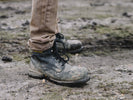
How to Break In Your New Work Boots
, by Ed Stone, 5 min reading time

, by Ed Stone, 5 min reading time
The most important aspect of breaking in a boot is to buy the correct fit to start with. With the correct fit, break-in will be easier and the shoe will last longer and provide the user with better performance. People commonly defer to the size of the shoe when purchasing boots, however, this can lead to discomfort and should only be used as a starting point to find your perfect fit. The proper way to fit your boots (both men's slip-on work boots and lace-ups and women’s pull on work boots and lace-ups) is to ensure that the widest part of your foot, aka the ball, is in the widest part of the shoe and that you have plenty of toe room. The shoe should fit “snug” in the width. With a fit like this, break-in should be minimal depending on the type of shoe/boot
The second best way to break in any pair of shoes is to wear them, so while you're trying the following ideas, keep wearing those shoes and make sure to feel for all the tight and stiff areas that need a little extra help.
The first piece of advice we can give you is never to buy a pair of safety work boots a day before you need to wear them or if you are having problems with your feet. Wait until your feet are in good shape, and you have some time to get used to them before shopping for a new pair of shoes.
Once you have purchased a pair of boots remember that it is going to take some time to break them in. With this in mind, it’s often recommended you bring an extra pair of shoes with you to work for the first few days so you can rotate between shoes as needed. The general rule is that the lighter weight the boot, the less time it will require to break in. A very heavy boot with thick soles and extra-thick leather will naturally take more time to break in then a boot that has less “bulk” to it so plan accordingly.
At Boot World, we’ve tried it all and found that nothing works quite as well as a good old fashioned oil treatment when it comes to breaking in your work boots. This ensures your leather has enough natural lubrication in the fibers to quickly mold to your shape.
If you purchased a heavy work leather that is already oiled, simply start gently wearing them. If the leather feels dry, add some leather oil or conditioner to the entire leather uppers of your boots to soften the leather fibers. Remember that oil may darken lighter colored leather but it will help keep it nourished in the long run.
An old trick for really heavy, all-leather boots that are super stiff is to soak the leather shoe with warm water and walk around in them until they are dry. The concept is that the wet leather will shape and mold more easily; however, constantly over wetting the leather can age the leather so make sure if you do this you have the time to wear it dry and oil the leather afterward.
What should you do with pressure points?
In the unliklely event pressure points show up once you start wearing your boots to work, but there are a couple of ways to take care of them.
Rubbing alcohol causes leather fibers to soften and expand. You can use a 1-part alcohol 1-part water solution on the entire work boot or just on the pressure points. Spritz it into the leather uppers into the areas that hurt the most or are tight, then wear your boot until dry. Repeat the treatment whenever the leather gets tight.
The two main reasons for blisters are ill-fitting shoes or moisture. If your shoe is too big, you will spend the day slipping and rubbing up against the heel or other areas. Moisture from sweat can make your skin soft and susceptible to blisters. Preventing a blister can be as easy as getting a pair of new leather boots that fit your feet and making sure you are wearing a sock that fits well and wicks moisture. Stay away from cotton if sweat or moisture, even from the outside, is an issue.
Once you have broken in your boots at home and have established the perfect fit, it is time to wear them to work. Bring an extra pair of shoes for those first few days, though. Never try to wear a new pair of leather work boots for an entire 12 to 15-hour shift and remember no amount of breaking in will help if the shoe does not fit. If you give it some time and try a few of the tips we mentioned, you should not have too many problems with your work boots. But, if you opt for comfortable and lightweight boots that still protect your feet, then you might want to check out our men's lightweight work boots.
Interested in having your work boots fitted by a professional? Visit one of Boot Word’s locations today to get expert advice and input.
Ed Stone brings over 45 years of footwear knowledge and passion to his role as President of Boot World, a family-owned company and an industry leader in safety and occupational footwear. A second generation "shoe dog” Ed's footwear knowledge is unparalleled, serving as an informal advisor for some of the worlds largest footwear brands including Wolverine, Timberland PRO, and Reebok Works.
A lifelong Southern California resident, and ardent conservationist, Ed enjoys hiking and open water swimming.